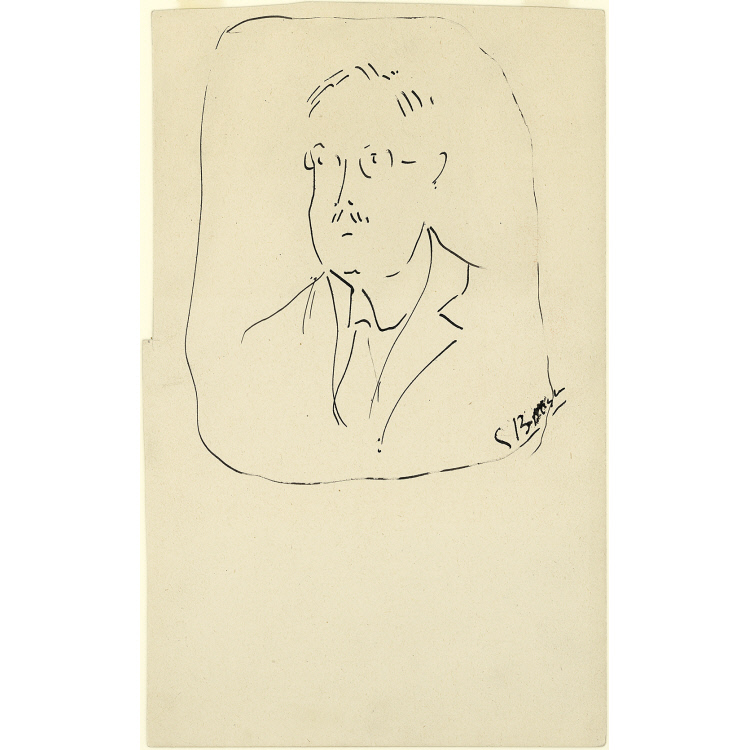Albert Eugene Gallatin
Painter, writer, patron, founder of the Gallery of Living Art at New York University, Albert Gallatin's contributions to abstract art in New York took many forms. Trained as a lawyer, Gallatin never practiced. Instead he concentrated his energies on collecting and writing about art. Initially interested in Aubrey Beardsley, James McNeill Whistler, the American Impressionists, and other turn-of-the-century artists, Gallatin turned to modern art in the 1920s.(1) By 1927, his collection had grown sufficiently to be shown publicly. He established the Gallery of Living Art, dedicated to the ongoing display of European moderns.(2) Located on Washington Square—near the studios of many young painters—New York University became home for his collection. There, Gallatin hoped to create an informal atmosphere for intellectual exchange, as well as a place where artists could congregate and study the newest developments in European art.
By 1933, when its second catalogue was published, the Gallatin Collection featured paintings by Céanne, Picasso, Braque, Léger, Gris, Mondrian, Ozenfant, Torres-Garcia, and others. With Jean Hélion, who served as advisor and friend, Gallatin increasingly focused his collection on a unified view of modernism. By 1937, its core artists were Picasso, Gris, Léger, and Braque. Masterworks purchased included Picasso's large Three Musicians and Léger's The City. Gallatin began adding work by American moderns as well.(3)
Gallatin's collecting brought him into contact with leading artists and groups of the day. He knew many of the members of Abstraction-Création, andits short-lived predecessor ArtConcret. He visited the studios of Picasso, Braque, Mondrian, Miró, and others, during his annual trips toParis. As important as his acquaintance with these artists was for his own painting, of greater significance was the link it provided between them and the growing circle of vanguard artists in New York.
Although many young Americansfollowed the Parisian art scene through Cahiers d'Art, Abstraction-Création, and othermagazines, the opportunity to study original work firsthand was unparalleled. Through purchases for the collections and backing for exhibitions, Gallatin lent significant support to his younger colleagues. He bought paintings by Rupert D. Turnbull, Gertrude Greene, Jean Xceron, Charles Biederman, John Ferren, George L.K. Morris, and Charles Shaw. He sponsored shows of work by Alice Trumbull Mason, Esphyr Slobodkina, and others. In 1936, under the auspices of the Gallery of Living Art, the Paul Reinhardt Galleries presented Five Contemporary American Concretionists, a widely reviewed exhibition of work by Biederman, Alexander Calder, Ferren, Morris, and Shaw.
Gallatin viewed modern art in international terms. He considered the gallery to be akin to a scientific laboratory where experimentation and explorationwere documented.(4) Hélion agreed, and in an essay for the 1933 catalogue of the collection, further argued that the newest developments should be understood as part of an evolutionary process. The concerns of "politics and the struggle for life," so popular among Social Realists, had no place in modern art.(5)
In December 1942, New YorkUniversity determined to retrieve the space occupied by the Gallatin collection. Looking about for another site, Gallatin rebuffed overtures from Alfred Barr at the Museum of Modern Art because he found Barr's lack of sympathy for younger American abstract artists disturbing. He gave the collection to the PhiladelphiaMuseum of Art.
Although Gallatin's perceptive eye benefited from the advice of Hélion, Morris, and others, his acute understanding of the formal basis of Cubism and other modernist forms is clear from his own paintings. During the mid 1920s, when Gallatin was fifty-five, he began painting in a modified Cubist style.Both the Untitled canvas of 1936 and Composition (1937) reflect Gallatin's admiration for Juan Gris, whose "honest and profound paintings, so free from all pretention, take on more and more weight year by year."(6)
Although Gallatin provided substantialmoral and financial support for the American Abstract Artists, and was among the early, although not original members, he was both older and considerably wealthier than most of its members. Along with Charles Shaw, George L.K. Morris, and Suzy Frelinghuysen, Gallatin was dubbed a "Park Avenue Cubist." He remained a man whose elegant life style set him apart from the younger, poorer members of the group.
1. Gallatin's first major publicationappeared in 1903: Aubrey Beardsley's Drawings. The following year he wrote Whistler's Art Dicta; additional volumes on Whistler appeared in 1907 and 1912.
2. Among the almost seventy works featured in the opening exhibition of the Gallery of Living Art were paintings by Braque, Céanne, Chagall, de Chirico, Gris, Léger, and Picasso.
3. Figurative art took a second place in the collection, and Gallatin removed from the collection work by Pavel Tchelitchew, Morris Kantor, Max Ernst, and Henry Billings. Surrealists were also discarded, although Miró and Masson, due to "technical virtuosity", remained within the gallery's purview. He reduced his holdings to one work each by Marin, Demuth, and Sheeler, but added Calder, Ferren, Morris, Shaw, and others whose work had direct links to recent European art.
4. Gallatin was delighted that the Museum of Living Art occupied the space used by Samuel F. B. Morse when he developed the electric telegraph.
5. Jean Hélion, letter to Albert E. Gallatin, 21 November 1934, Albert Gallatin Papers, Archives of American Art, Smithsonian Institution, Washington, D.C., roll 507: 404.
6. Albert Gallatin, "Abstract Painting and the Museum of Living Art," Plastique 3 (Spring 1938): 9.
Virginia M. Mecklenburg The Patricia and Phillip Frost Collection: American Abstraction 1930–1945 (Washington, D.C.: Smithsonian Institution Press for the National Museum of American Art, 1989










